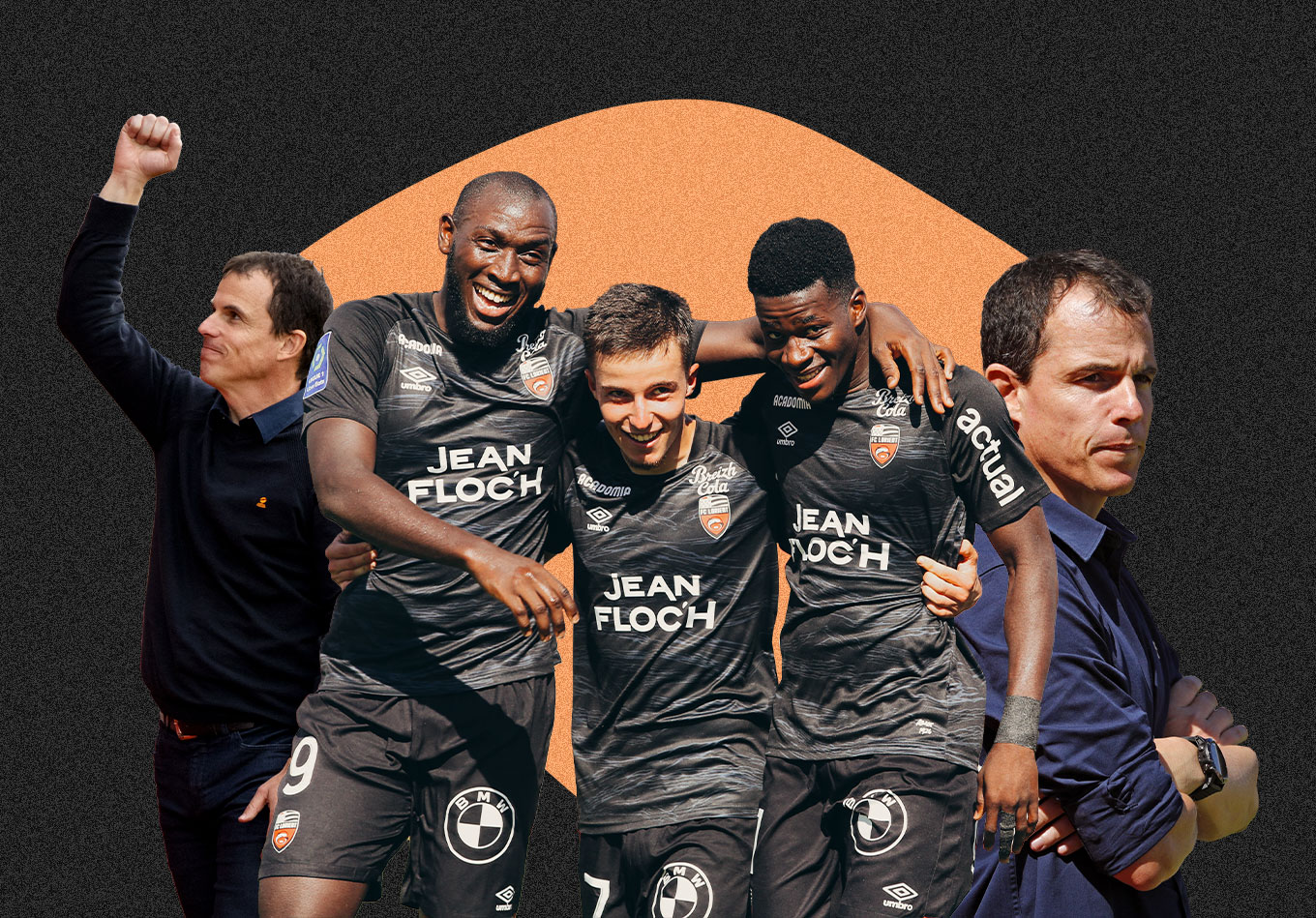If someone tried ranking the big leagues on their competitiveness, it’s very unlikely that they’d put Ligue 1 towards the top. We know all about Paris Saint-Germain’s dominance in the league as well as the financial strength they enjoy, and someone else sustaining a challenge for the crown looks more unlikely with every passing season.
As a consolation prize, however, look one step down from the throne and you see a picture of constant change, heterogeneity, and upward mobility, with a few clubs with more humble balance sheets challenging for the higher spots. These sides come armed with exciting talents and distinctive, eye-catching tactics that power them to the top. Examples include Lens since gaining promotion, Montpellier from time to time, and Strasbourg last season.
But this season’s new entry seems to fit the bill like no other. FC Lorient only won promotion to Ligue 1 two seasons ago and finished 16th last season, but right now, they sit in second place, only three points behind PSG. It’s a position that seems unimaginable for a club with a highest-ever finish in Ligue 1 of seventh and one of the lowest wage bills in the league.
And they’re doing it under a new manager who’s in his first season of managing senior football. 46-year-old Régis Le Bris has spent the last 19 years in senior coaching roles at academies. After a year at Wasquehal, he spent around seven years as Rennes’ head of academy coaching, before taking charge of Lorient’s U19 side in 2012. Working his way up into managing the academy and then managing Lorient B, his big break came when he replaced Christophe Pélissier this June. It’s not just the club that fits the mould of the underdog.
What’s more, it’s not just their position in the league table that looks pretty. After they win the ball back with their low block, their fluid and positional yet direct attack is worth spending hours to watch. Their style, coupled with a talented set of attackers, is one for the neutrals.
Let’s take a deeper look at what they do with the ball and what makes them unique.
The Underlying Numbers
Here’s the thing: they’re overperforming their expected goals (xG) by a fairly large margin. While they’ve scored the third-most goals in the league (21), tied with Montpellier and Lille, they’ve only created the eighth most xG (15.83). Their open-play numbers are around par (12 goals scored from 11.51 xG) so set pieces are where the brunt of their overperformance – five goals from 1.95 xG – comes from. As much as I don’t want it to be true, their attack may not overperform their underlying numbers at the same rate going forward.
But at the same time, they’re still overperforming their xPectations (sorry) and punching above their weight. Being in the top ten for underlying numbers in attack is a remarkable improvement a side that was tied at the bottom of the table for goals scored last season and put up the eighth lowest xG. This is a side that’s very much exceeding expectations in every sense, and it’s worth looking at what they’re doing this season under Le Bris that’s resulted in this upswing. Lorient are a fascinating attacking side, both on the pitch and in the spreadsheets…
Ball Progression and Territory
Potentially the most interesting thing about Lorient’s general statistical vitals is that they move the ball into dangerous areas very rarely. No side attempts fewer passes into the final third than Lorient with their 44 per game. Their count is almost 10% lower than that of the next-lowest side, Nice. In addition, no club completes a lower share of their passes in the attacking third (25%).
Clearly, they don’t move the ball around or into advanced areas much. This looks at odds with the fact that they’ve scored the joint-second-most goals in the league with respectable underlying figures. Of course, we don’t exactly know the link between ball progression and sustainably scoring goals in the long term; whether you always need strong ball progression numbers to keep scoring. But what’s clear is that it poses some questions about what it is that Lorient do with the ball…
Attacking Style
1. They Are a Low-Possession Side and Attack Fairly Directly
As we mentioned earlier, Lorient don’t control games – in the conventional sense, at least – and this is also reflected in their possession numbers. They keep the second-lowest share of possession (42.4%) in the league. This is largely down to their passivity without the ball, recording the highest PPDA (passes per defensive action; a lower PPDA indicates greater pressing intensity) in the league with 16.4. But on the attacking side, they’re also a fairly fast-moving, direct side. You can see them in the top-left quadrant here:
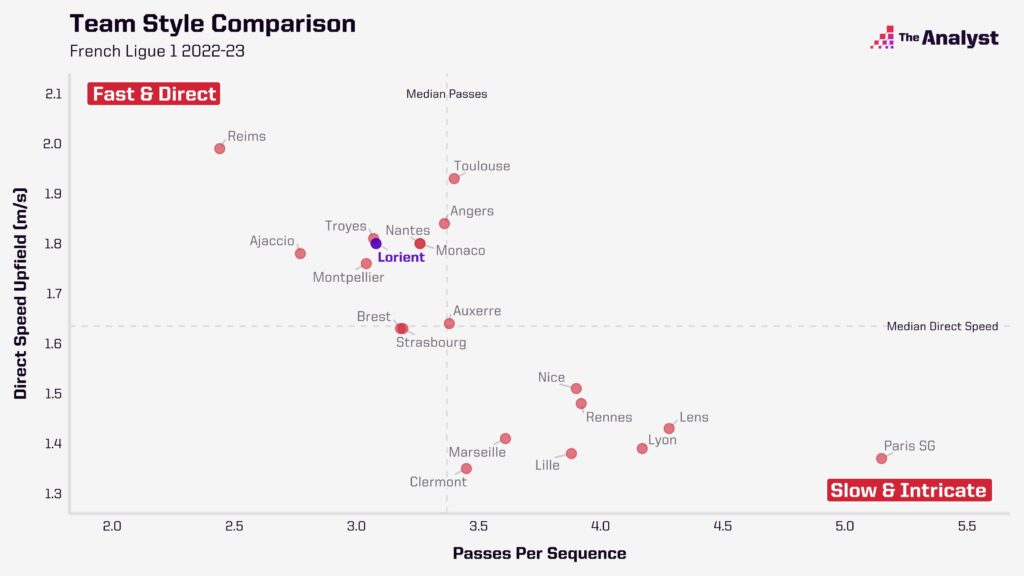
On average, they move forward at a speed of 1.8 metres per second, the fifth-highest in the league. More of their attacks fall under what Opta defines as ‘direct attacks’ (21) than ‘build-up attacks’ (20).
But they don’t move forward at a constant pace, and it’s often difficult to categorise their attacks as being ‘direct’ or stemming from ‘build-ups’. Which takes us to…
2. They Pass the Ball Around a Lot Close to Their Goal, Baiting the Press
Lorient love to move it around close to their goal. As we mentioned earlier, Lorient don’t play a lot of passes in the final third.
Where, then, do all their passes go? On the other end of the pitch – 32% of their passes end in their own third, the highest proportion in the league.
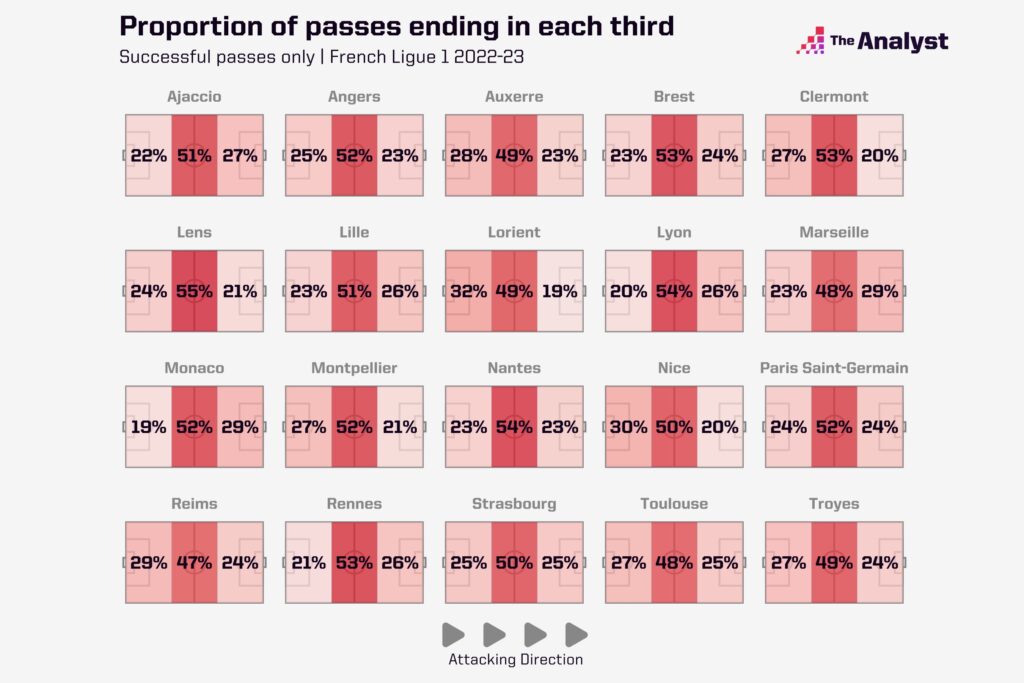
They start from a position like this, drifting between a 4-2-3-1 and a 4-3-3.
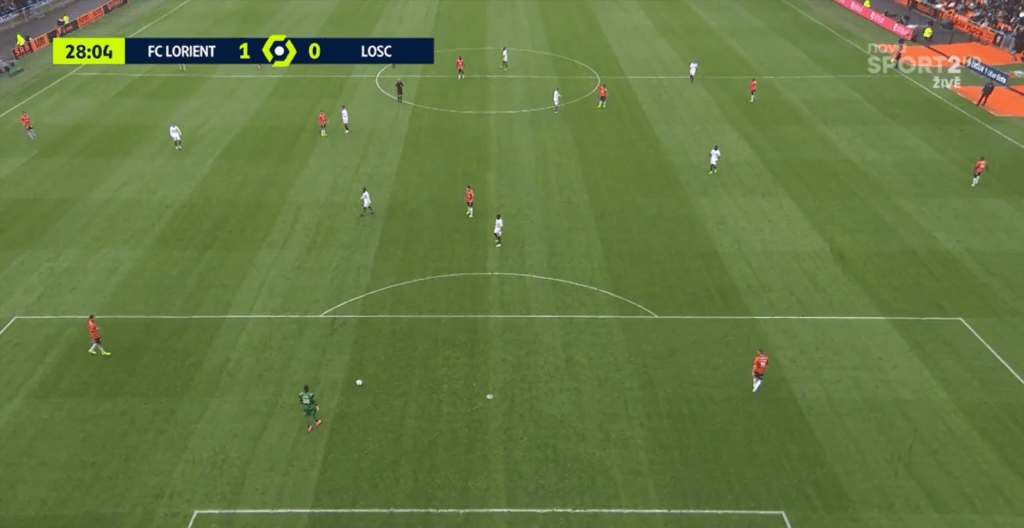
With the back four, one of the deeper midfielders dropping back, and the goalkeeper serving as available options in the build-up, Lorient outnumber the opposition’s high press. Having extra players to create positional superiorities in the build-up looks like a deliberate choice from Le Bris.
“As far as our approach to the positional attack is concerned,” he told the blog FC Lorient Actus, “we indeed work a lot on numerical superiorities at the start of the game and in midfield.” As most sides do, they seem to organise themselves in fluid triangles in the build-up, which is another aspect that seems deliberate, as Le Bris also talked of triangles serving as “landmarks” for players in position.
What this passing does for Lorient in the build-up is that it attracts the opposition’s press out and opens up spaces that they can exploit. It’s what enables the pace they move forward with from settled possession, which is something we’ll discuss in a bit.
Plus, they also occasionally move their attack backwards, often all the way to goalkeeper Yvon Mvogo, who’s a relatively active keeper in the build-up with 28.6 passes attempted per 90, the sixth most in the league among goalkeepers. Not only does this absorb pressure but it also helps them re-open spaces between opposition lines. A minor example is the build-up to Enzo Le Fée’s goal against Auxerre.
In general, their build-up is unique for low-possession sides, and it sets the foundation for what they do further up the pitch. And on that note…
3. In the Final Third, They Make Sudden Accelerations and Attack Directly With Incisive off-Ball Movement
The final third is where their attacking pace and their efficiency in turning possession into opportunities become clear. Lorient move forward quickly in the opposition’s half, swiftly breaking lines and slicing through channels. While this may be influenced by me being a sucker for good off-ball movement, it looks like what Lorient do off the ball in possession is the key to their success in the final third.
The most noticeable aspect of their movement is how often players make underlapping runs from deeper, wider areas. For example, in this wonderfully Lorient-y goal with fluid movement and interchanges, have a look at attacking midfielder Julien Ponceau’s run before his assist for Dango Ouattara. If you’re not distracted by Le Fée briefly being possessed by the spirit of Thiago for that pre-assist, that is.
Another thing that’s especially clear in counter-attacks is their third-man runs from deeper. Look at Ouattara here for his goal.
From double-movements to up-back-and-throughs, it looks like the most interesting things that Lorient do happen off the ball. Of course, a lot of their success high up the pitch comes down to the squad’s ability on the ball, particularly with Le Fée’s passing and Outtara’s dribbling, but what’s evident is that this is usually enabled by all their fluidity, innovation, and systemic excellence without the ball.
4. They Rarely Use Crosses and Set Pieces to Create Chances
Many sides with lower budgets tend to, or are forced to, try and create chances with crosses. Lorient aren’t one of these sides. Only 6.3% of their open-play chances have been assisted by crosses, the lowest in the league. The majority of the chances they create come from the central areas of the pitch, as you can see here.
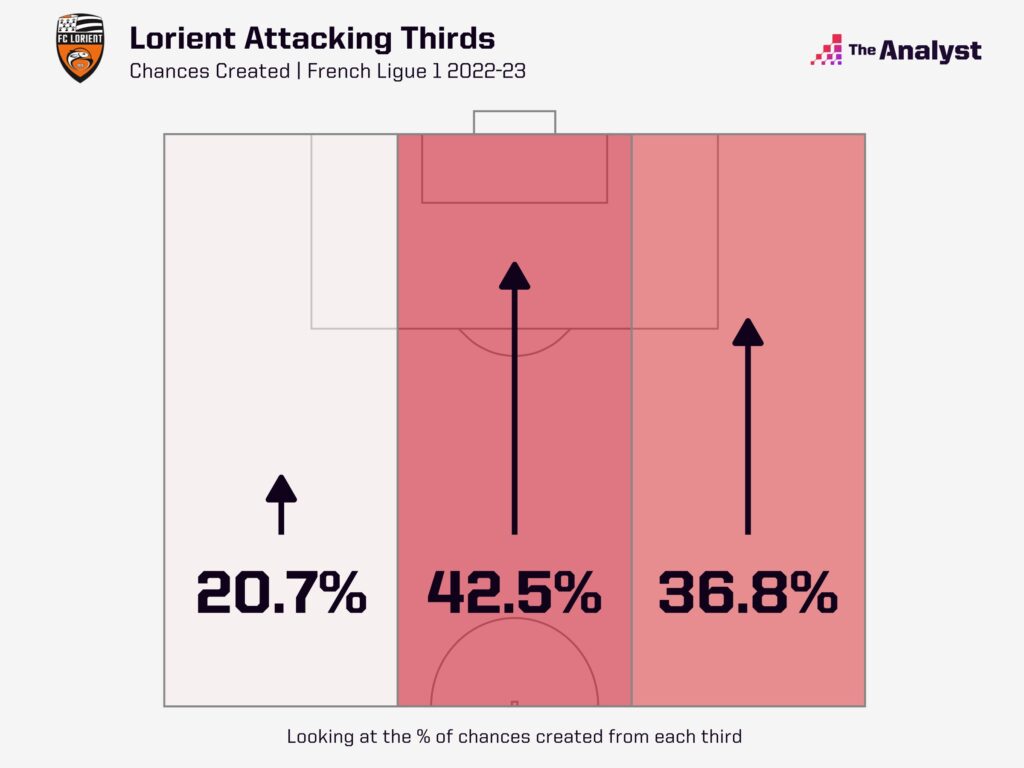
A fair portion of these chances from the middle third are assisted by slightly longer, diagonal passes.
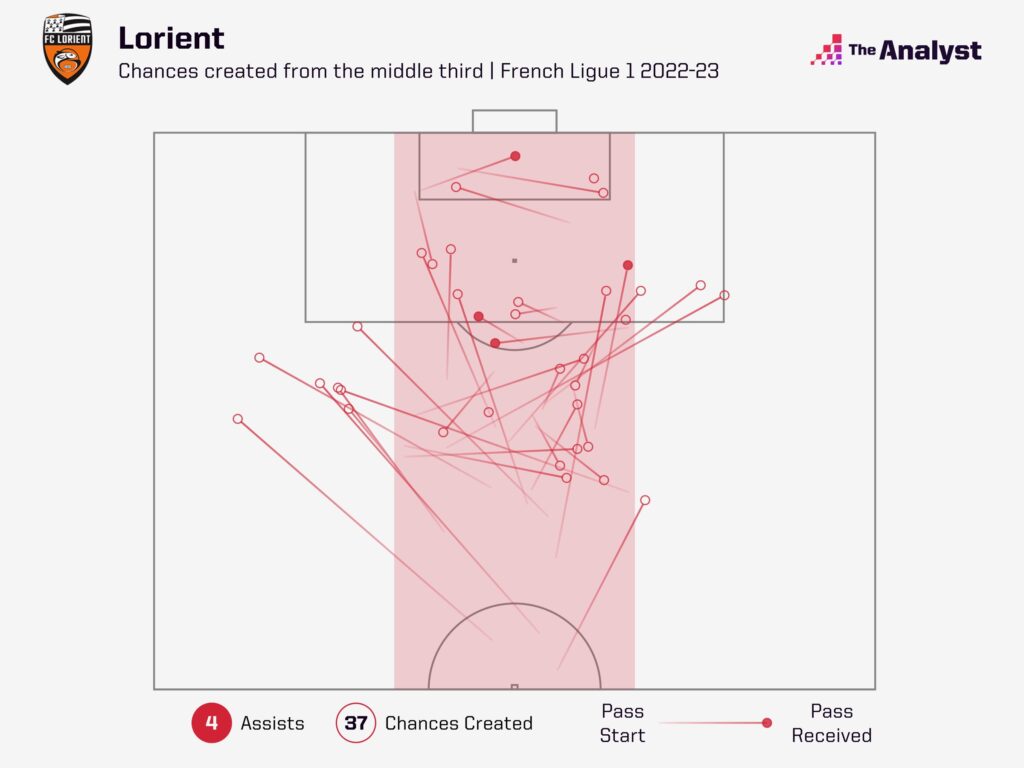
Similarly, as mentioned earlier, Lorient don’t do much from set pieces either, creating only 1.95 xG, the second lowest from set pieces in the league. This is a side that relies on its incisive possession to score goals.
5. A Drawback With Their Deep Passing Is That They Lose the Ball Close to Their Own Goal and Get Hit on the Transition
Unfortunately, Lorient often find themselves flying too close to the sun with their build-up play, giving the ball away close to their own goal often enough to awaken any old-school ex-player on a half-time talk-show. They’ve conceded 120 high turnovers, possession losses within 40 metres of their goal, the highest in the league. A large number of these turnovers come from when they’re boxed in by the press in wide areas, as you can see in the map here.
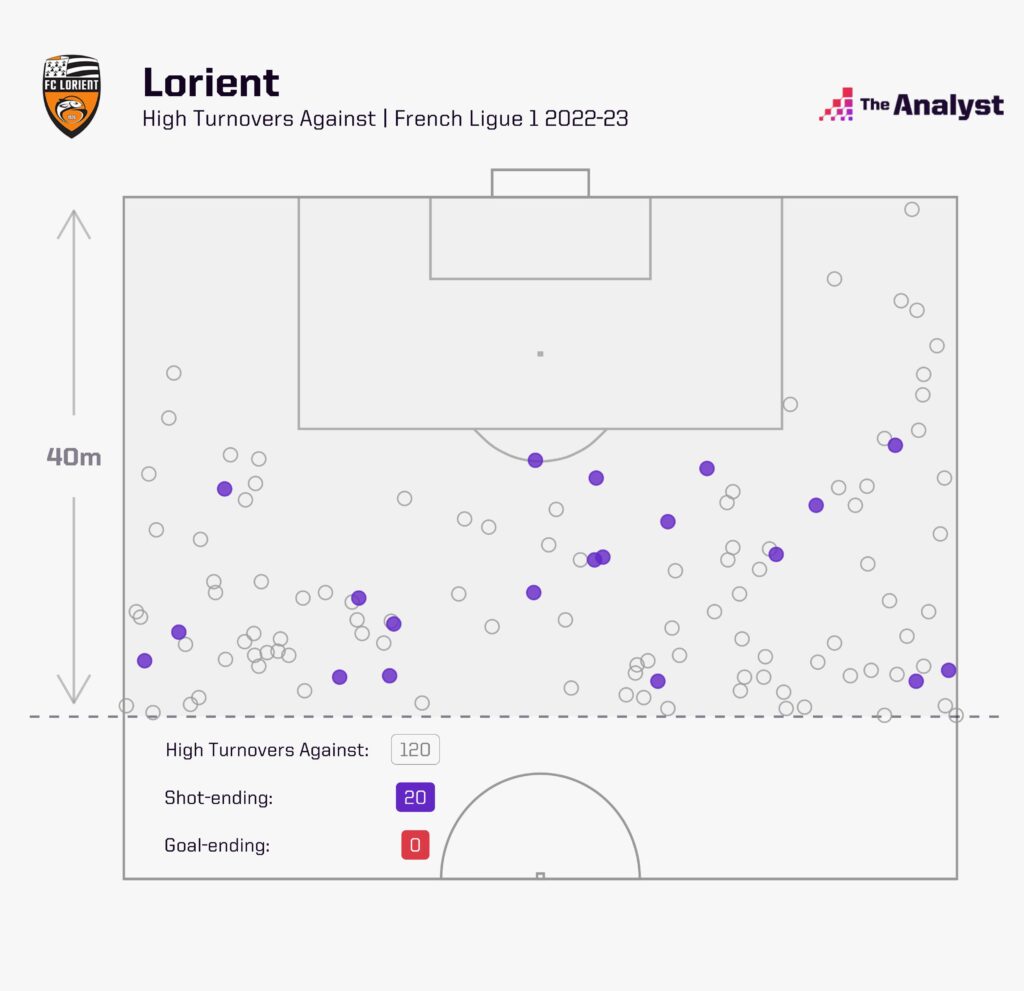
20 of these high turnovers also result in shots, which is the second-highest in the league. These transitions haven’t resulted in any goals being scored against them, but with this regularity, it’s only a matter of time.
This weakness is a defensive drawback that is a natural trade-off from their attacking style, but shoring up these turnovers can go a long way in solidifying the long-term stability of their defence.
Their Personnel
When we write about tactics, especially about those of overachieving sides, we tend to fall into the trap of talking about players like they’re interchangeable checkers pieces that the manager has complete control over. But it’s obvious to anyone who’s watched a little bit of Lorient this season that they have a set of young, talented players in attack who power Le Bris’s system.
With eight goals, Lorient’s 23-year-old striker Terem Moffi is tied with Kylian Mbappé for the second-most goals in the league. He’s bounced back after a less prolific season last campaign, and offers a versatile focal point for Lorient’s attack. His movement is intelligent, often changing his trajectory to create space for himself, and his skill with the ball and his strength make him a great out-ball for the attack. He’s overperforming his xG by a lot and it’s unlikely that he’s going to keep this scoring rate up, but his ability on and off the ball allows him to create very high-quality chances for himself (just look at that xG/shot) and he keeps the attacking system oiled and ticking even when he doesn’t score.
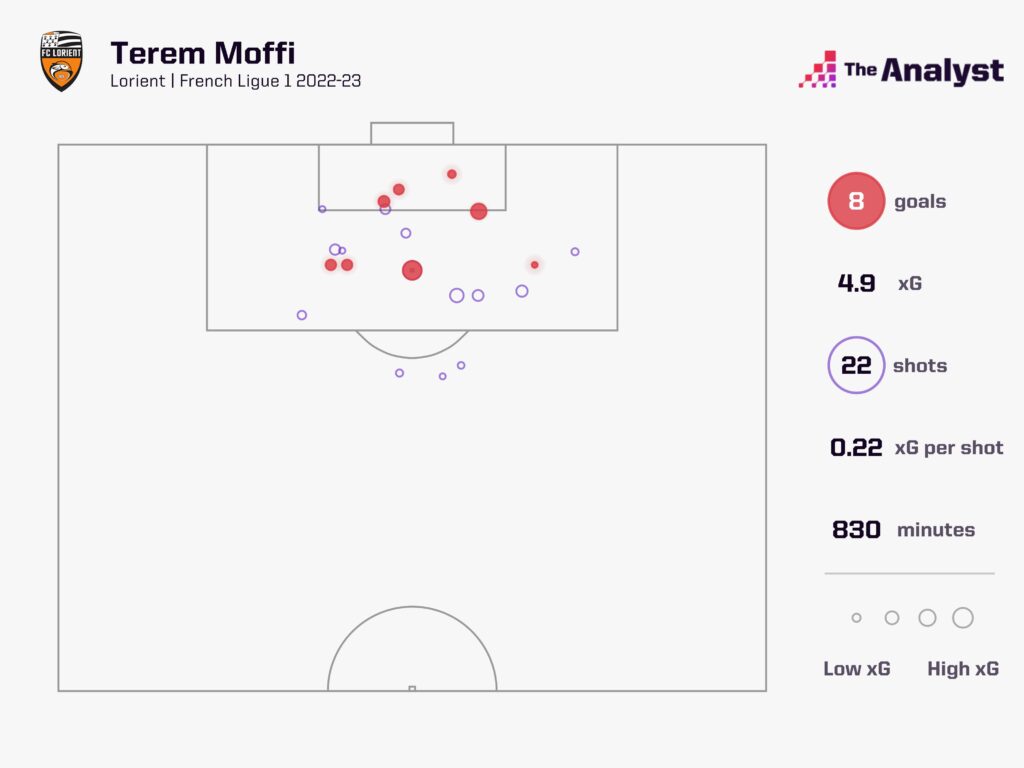
Then there’s a darling of both the compilation-maker and the stathead, Ouattara. The 20-year-old winger’s a serious double-threat with both the ball at his feet and off the ball, with his dribbling ability and his movement. He puts up 0.34 xG per 90 (19th in the league), and is a productive chance-creator too with 0.24 xA p90 (10th).
Only Mbappé has created more shots for himself or for his team-mates from dribbling than Ouattara’s 18 chance-creating carries.
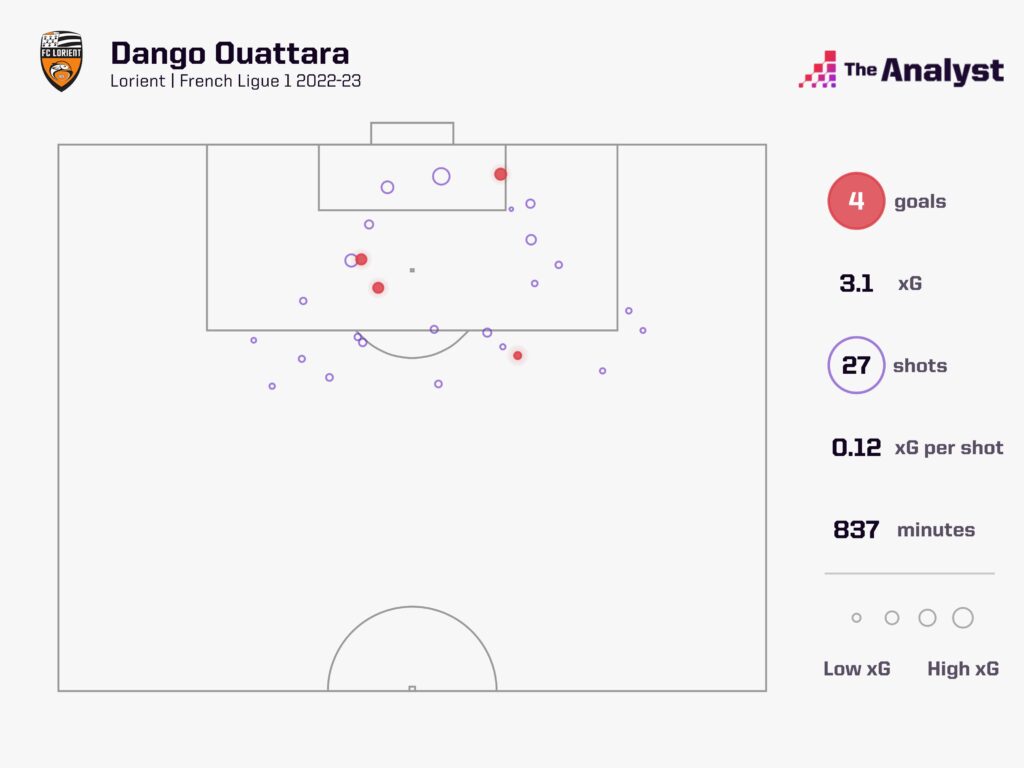
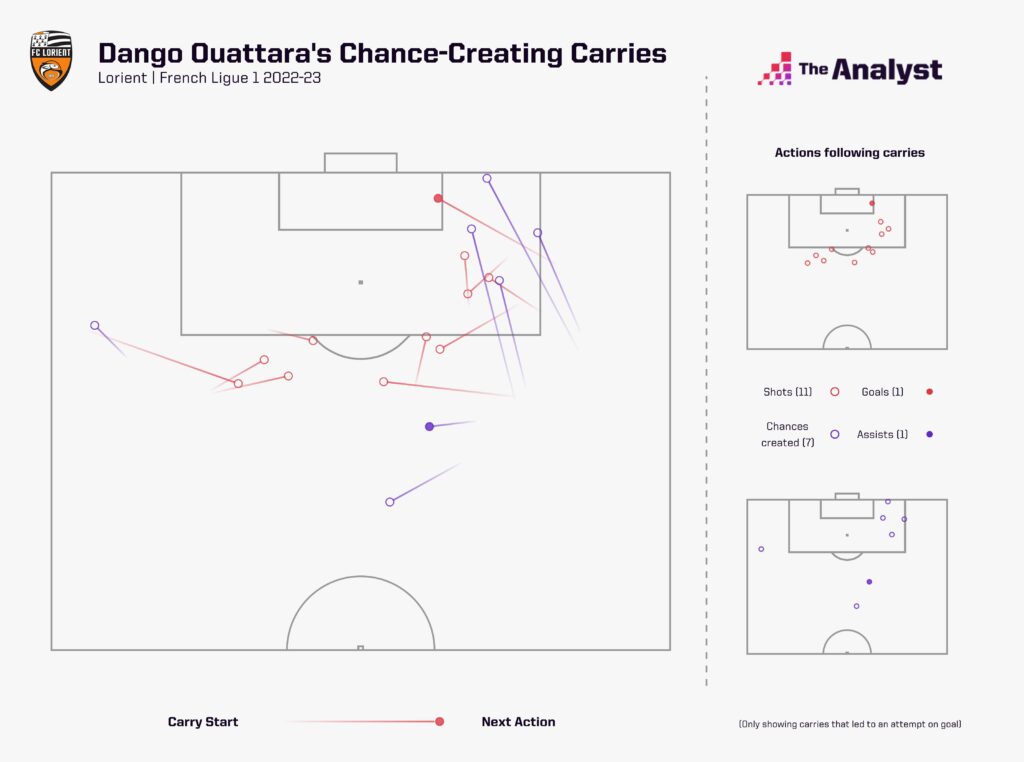
And finally, the gem in the crown, Enzo Le Fée. You don’t need to make up a Vicente Del Bosque quote to appreciate him because he’s very hard to miss on the pitch. He’s someone who’s involved in every stage of Lorient’s attack.
Le Fée’s positioning dictates the shape of the side. He carries the ball through pressure, unsettling defences. He breaks opposition defensive lines with his passes. He also always offers a passing option with his positioning and movement, often moving between lines.
Here’s an example of him (number 10) conducting a possession move from the defensive third to the final third, even taking the shot in the end.
As we discussed earlier, Lorient start slow in possession and then accelerate as they move upfield. Le Fée’s the guy who usually speeds up attacks almost single-handedly with his passing, dribbling, and movement. In the attacking third, he usually goes for riskier, incisive passes that breach the last line and put players in free space. And more often than not, he pulls them off. For example, take a look at how long most of his chance-creating passes are.
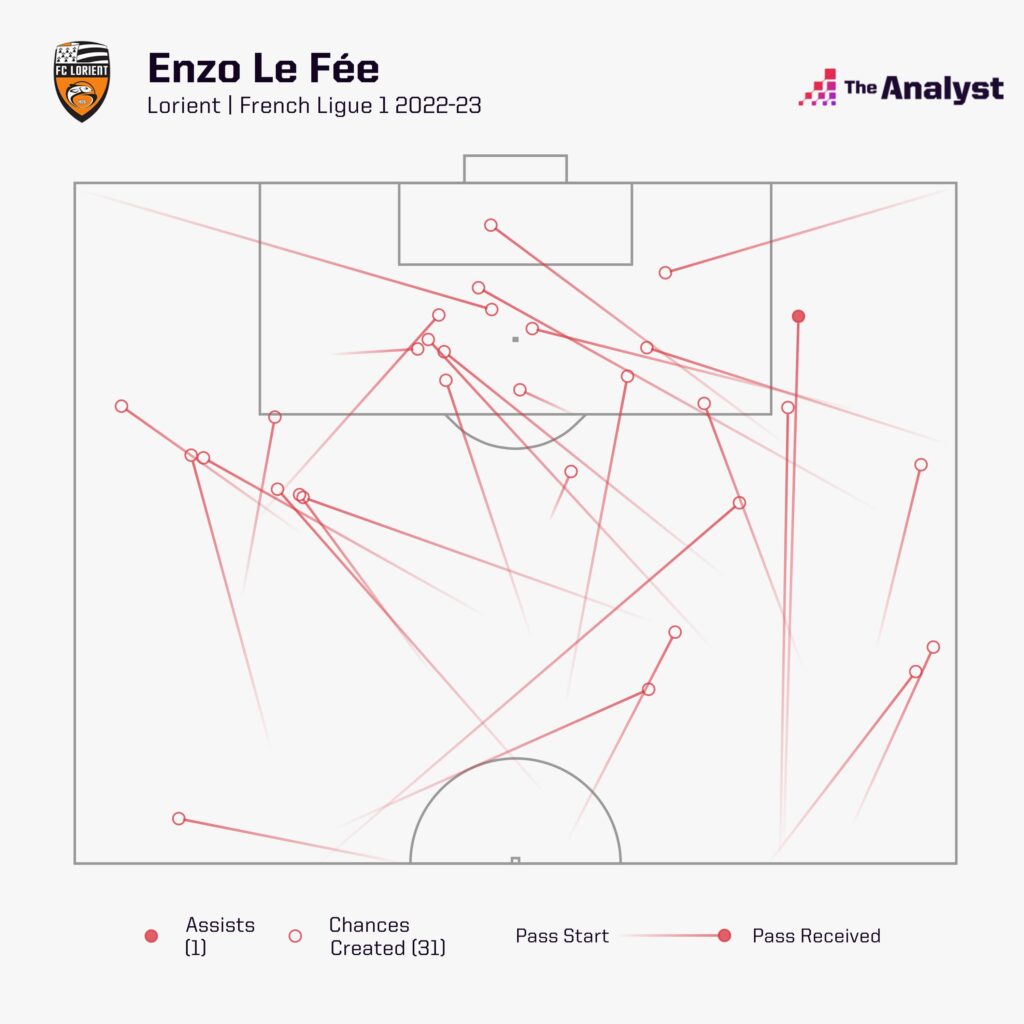
These stars don’t tell the full story either, because this is a talented set of players overall. We’ve not yet mentioned Football Manager favourite Adil Aouchiche, who’s spent this season so far mostly injured. One common factor among all their players is that they all seem to have levelled up a notch this season, which says something about the influence of Le Bris’s tactical system and coaching. Until the big sharks circle, this Lorient side is going to be a lot of fun to watch with that set of players.
There’s little doubt that Lorient are going to end the season in a slightly lower position than where they are now. There’s also no doubt that they’re far from a finished product. But even their underlying numbers suggest that they’re doing far better than anyone imagined they could. And the best part? It’s how fun they are while doing it.
With good possession football; entertaining, direct, young players with layered skillsets; an exciting new manager; and the vibes of a plucky underdog, Lorient have something for everyone to enjoy this season.
Enjoy this? Subscribe to our newsletter to receive exclusive content.
